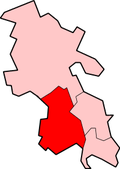| Skirmett | |
|---|---|
| Hamlet | |
 The Old Shop in Skirmett | |
Location within Buckinghamshire | |
| OS grid reference | SU775899 |
| Civil parish | |
| Unitary authority | |
| Ceremonial county | |
| Region | |
| Country | England |
| Sovereign state | United Kingdom |
| Post town | HENLEY-ON-THAMES |
| Postcode district | RG9 |
| Dialling code | 01491 |
| Police | Thames Valley |
| Fire | Buckinghamshire |
| Ambulance | South Central |
| UK Parliament | |
Skirmett is a hamlet in the parish of Hambleden, in Buckinghamshire, England. It lies in the Hambleden Valley in the Chiltern Hills, between the villages of Hambleden and Fingest.




